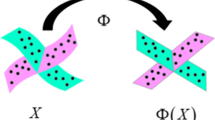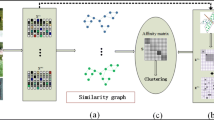Abstract
Multi-view subspace clustering has been an important and powerful tool for partitioning multi-view data, especially multi-view high-dimensional data. Despite great success, most of the existing multi-view subspace clustering methods still suffer from three limitations. First, they often recover the subspace structure in the original space, which can not guarantee the robustness when handling multi-view data with nonlinear structure. Second, these methods mostly regard subspace clustering and affinity matrix learning as two independent steps, which may not well discover the latent relationships among data samples. Third, many of them ignore the different importance of multiple views, whose performance may be badly affected by the low-quality views in multi-view data. To overcome these three limitations, this paper develops a novel subspace clustering method for multi-view data, termed Kernelized Multi-view Subspace Clustering via Auto-weighted Graph Learning (KMSC-AGL). Specifically, the proposed method implicitly maps the multi-view data from linear space into nonlinear space via kernel-induced functions, so as to exploit the nonlinear structure hidden in data. Furthermore, our method aims to enhance the clustering performance by learning a set of view-specific representations and their affinity matrix in a general framework. By integrating the view weighting strategy into this framework, our method can automatically assign the weights to different views, while learning an optimal affinity matrix that is well-adapted to the subsequent spectral clustering. Extensive experiments are conducted on a variety of multi-view data sets, which have demonstrated the superiority of the proposed method.






Similar content being viewed by others
Notes
The improvement is computed by \(\frac {\mathrm {The KMSC-AGL result - The best baseline result}}{\mathrm {The best baseline result}} \times 100\% \).
References
Huang S, Kang Z, Tsang IW, Xu Z (2019) Auto-weighted multi-view clustering via kernelized graph learning. Pattern Recogn 88:174–184
Chen MS, Huang L, Wang CD, Huang D (2020) Multi-view clustering in latent embedding space. In: Thirty-fourth AAAI conference on artificial intelligence
Gao H, Nie F, Li X, Huang H (2015) Multi-view subspace clustering. In: Proceedings of the IEEE international conference on computer vision, pp 4238–4246
Zhang C, Hu Q, Fu H, Zhu P, Cao X (2017) Latent multi-view subspace clustering. In: Proceedings of the IEEE conference on computer vision and pattern recognition, pp 4279–4287
Zhou T, Liu M, Thung K, Shen D (2019) Latent representation learning for alzheimer’s disease diagnosis with incomplete multi-modality neuroimaging and genetic data. IEEE Trans Medical Imaging 38(10):2411–2422
Zhou T, Thung K, Liu M, Shi F, Zhang C, Shen D (2020) Multi-modal latent space inducing ensemble SVM classifier for early dementia diagnosis with neuroimaging data. Medical Image Anal 60:101630
Chen X, Xu X, Huang JZ, Ye Y (2013) Tw-k-means: automated two-level variable weighting clustering algorithm for multiview data. IEEE Trans Knowl Data Eng 25(4):932–944
Zhang GY, Wang CD, Huang D, Zheng WS, Zhou YR (2018) Tw-co-k-means: two-level weighted collaborative k-means for multi-view clustering. Knowl-Based Syst 150:127–138
Liu X, Dou Y, Yin J, Wang L, Zhu E (2016) Multiple kernel k-means clustering with matrix-induced regularization. In: Thirtieth AAAI conference on artificial intelligence
Zhou S, Zhu E, Liu X, Zheng T, Liu Q, Xia J, Yin J (2020) Subspace segmentation-based robust multiple kernel clustering. Information Fusion 53:145–154
Liu J, Wang C, Gao J, Han J (2013) Multi-view clustering via joint nonnegative matrix factorization. In: Proceedings of the SIAM international conference on data mining, pp 252–260. SIAM
Huang L, Chao HY, Wang CD (2019) Multi-view intact space clustering. Pattern Recogn 86:344–353
Lin KY, Huang L, Wang CD, Chao HY (2018) Multi-view proximity learning for clustering. In: Proceedings of the international conference on database systems for advanced applications, pp 407–423. Springer
Wang H, Yang Y, Liu B, Fujita H (2019) A study of graph-based system for multi-view clustering. Knowl-Based Syst 163:1009–1019
Xia R, Pan Y, Du L, Yin J (2014) Robust multi-view spectral clustering via low-rank and sparse decomposition. In: Proceedings of the twenty-eighth AAAI conference on artificial intelligence, pp 2149–2155
Nie F, Cai G, Li X (2017) Multi-view clustering and semi-supervised classification with adaptive neighbours. In: Proceedings of the thirty-first AAAI conference on artificial intelligence, pp 2408–2414
Nie F, Li J, Li X (2017) Self-weighted multiview clustering with multiple graphs. In: Proceedings of the twenty-sixth international joint conference on artificial intelligence, pp 2564–2570
Zhan K, Zhang C, Guan J, Wang J (2017) Graph learning for multiview clustering. IEEE Transactions on Cybernetics 48(99): 1–9
Wang X, Guo X, Lei Z, Zhang C, Li SZ (2017) Exclusivity-consistency regularized multi-view subspace clustering. In: Proceedings of the IEEE conference on computer vision and pattern recognition, pp 923–931
Brbić M, Kopriva I (2018) Multi-view low-rank sparse subspace clustering. Pattern Recogn 73:247–258
Luo S, Zhang C, Zhang W, Cao X (2018) Consistent and specific multi-view subspace clustering. In: Thirty-second AAAI conference on artificial intelligence
Tzortzis G, Likas A (2012) Kernel-based weighted multi-view clustering. In: Proceedings of the IEEE international conference on data mining, pp 675–684. IEEE
Zeng S, Wang X, Cui H, Zheng C, Feng D (2017) A unified collaborative multikernel fuzzy clustering for multiview data. IEEE Trans Fuzzy Syst 26(3):1671–1687
Wang S, Liu X, Zhu E, Tang C, Liu J, Hu J, Xia J, Yin J (2019) Multi-view clustering via late fusion alignment maximization. In: Proceedings of the 28th international joint conference on artificial intelligence, pp 3778–3784. AAAI Press
Li JH, Wang CD, Li PZ, Lai JH (2018) Discriminative metric learning for multi-view graph partitioning. Pattern Recogn 75:199–213
Liang Y, Huang D, Wang CD (2019) Consistency meets inconsistency: a unified graph learning framework for multi-view clustering. In: Proceedings of the IEEE international conference on data mining
Cao X, Zhang C, Fu H, Liu S, Zhang H (2015) Diversity-induced multi-view subspace clustering. In: Proceedings of the IEEE conference on computer vision and pattern recognition, pp 586–594
Zhang GY, Zhou YR, He XY, Wang CD, Huang D (2019) One-step kernel multi-view subspace clustering. Knowledge-based Systems p 105126
Moradi P, Rezaimehr F, Ahmadian S, Jalili M (2016) A trust-aware recommender algorithm based on users overlapping community structure. In: 2016 sixteenth international conference on advances in ICT for emerging regions (ICTer), pp 162–167. IEEE
Hu QY, Zhao ZL, Wang CD, Lai JH (2017) An item orientated recommendation algorithm from the multi-view perspective. Neurocomputing 269:261–272
Ahmadian S, Joorabloo N, Jalili M, Meghdadi M, Afsharchi M, Ren Y (2018) A temporal clustering approach for social recommender systems. In: 2018 IEEE/ACM international conference on advances in social networks analysis and mining (ASONAM), pp 1139–1144. IEEE
Ahmadian S, Joorabloo N, Jalili M, Ren Y, Meghdadi M, Afsharchi M (2020) A social recommender system based on reliable implicit relationships. Knowl-Based Syst 192(105):371
Moradi P, Ahmadian S, Akhlaghian F (2015) An effective trust-based recommendation method using a novel graph clustering algorithm. Physica A: Statistical Mechanics and its Applications 436:462–481
Ahmadian S, Meghdadi M, Afsharchi M (2018) Incorporating reliable virtual ratings into social recommendation systems. Appl Intell 48(11):4448–4469
Rezaeimehr F, Moradi P, Ahmadian S, Qader NN, Jalili M (2018) Tcars: time-and community-aware recommendation system. Futur Gener Comput Syst 78:419–429
Guo G, Zhang J, Yorke-Smith N (2015) Leveraging multiviews of trust and similarity to enhance clustering-based recommender systems. Knowl-Based Syst 74:14–27
Hu QY, Huang L, Wang CD, Chao HY (2019) Item orientated recommendation by multi-view intact space learning with overlapping. Knowl-Based Syst 164:358–370
Elhamifar E, Vidal R (2013) Sparse subspace clustering: algorithm, theory, and applications. IEEE Transactions on Pattern Analysis and Machine Intelligence 35(11):2765–2781
Lu CY, Min H, Zhao ZQ, Zhu L, Huang DS, Yan S (2012) Robust and efficient subspace segmentation via least squares regression. In: Proceedings of the European conference on computer vision, pp 347–360. Springer
Liu G, Lin Z, Yan S, Sun J, Yu Y, Ma Y (2012) Robust recovery of subspace structures by low-rank representation. IEEE Transactions on Pattern Analysis and Machine Intelligence 35(1):171–184
Nie F, Wang X, Huang H (2014) Clustering and projected clustering with adaptive neighbors. In: Proceedings of the 20th ACM SIGKDD international conference on Knowledge discovery and data mining, pp 977–986. ACM
Xiao S, Tan M, Xu D, Dong ZY (2015) Robust kernel low-rank representation. IEEE Transactions on Neural Networks and Learning Systems 27(11):2268–2281
Burden R, Faires JD (2011) Numerical analysis. Cengage Learning, Boston
Nie F, Li J, Li X, et al. (2016) Parameter-free auto-weighted multiple graph learning: a framework for multiview clustering and semi-supervised classification. In: Proceedings of the twenty-five international joint conference on artificial intelligence, pp 1881–1887
Nie F, Cai G, Li J, Li X (2017) Auto-weighted multi-view learning for image clustering and semi-supervised classification. IEEE Trans Image Process 27(3):1501–1511
Wang CD, Lai JH, Philip SY (2015) Multi-view clustering based on belief propagation. IEEE Trans Knowl Data Eng 28(4):1007–1021
Lewis DD, Yang Y, Rose TG, Li F (2004) Rcv1: a new benchmark collection for text categorization research. Journal of Machine Learning Research 5(Apr):361–397
Brbić M, Piškorec M, Vidulin V, Kriško A, Šmuc T, Supek F (2016) The landscape of microbial phenotypic traits and associated genes. Nucleic Acids Research: gkw964 44:10074–10090
Zhang YF, Xu C, Lu H, Huang YM (2009) Character identification in feature-length films using global face-name matching. IEEE Transactions on Multimedia 11(7):1276–1288
Xie Y, Tao D, Zhang W, Liu Y, Zhang L, Qu Y (2018) On unifying multi-view self-representations for clustering by tensor multi-rank minimization. Int J Comput Vis 126(11):1157–1179
Zou X, Kittler J, Messer K, et al. (2005) Face recognition using active near-ir illumination. In: BMVC. Citeseer
Huang D, Wang CD, Lai JH (2017) Locally weighted ensemble clustering. IEEE Transactions on Cybernetics 48(5):1460–1473
Zhang GY, Zhou YR, Wang CD, Huang D, He XY (2021) Joint representation learning for multi-view subspace clustering. Expert Syst Appl 166(113):913
Wang H, Yang Y, Liu B (2019) Gmc: graph-based multi-view clustering. IEEE Transactions on Knowledge and Data Engineering
Zhang C, Fu H, Liu S, Liu G, Cao X (2015) Low-rank tensor constrained multiview subspace clustering. In: Proceedings of the IEEE international conference on computer vision, pp 1582–1590
Chen MS, Huang L, Wang CD, Huang D, Lai JH (2021) Relaxed multi-view clustering in latent embedding space. Information Fusion 68:8–21
Liu BY, Huang L, Wang CD, Fan S, Philip SY (2019) Adaptively weighted multiview proximity learning for clustering. IEEE Transactions on Cybernetics
Li X, Zhang H, Wang R, Nie F (2020) Multi-view clustering: a scalable and parameter-free bipartite graph fusion method. IEEE Transactions on Pattern Analysis and Machine Intelligence
Acknowledgments
The authors would like to thank the anonymous reviewers and the Associate Editor for their constructive comments and suggestions, which greatly improve this paper. This work was supported by the NSFC (61773410, 61673403, 61976097, 62006252).
Author information
Authors and Affiliations
Corresponding author
Additional information
Publisher’s note
Springer Nature remains neutral with regard to jurisdictional claims in published maps and institutional affiliations.
Rights and permissions
About this article
Cite this article
Zhang, GY., Chen, XW., Zhou, YR. et al. Kernelized multi-view subspace clustering via auto-weighted graph learning. Appl Intell 52, 716–731 (2022). https://doi.org/10.1007/s10489-021-02365-8
Accepted:
Published:
Issue Date:
DOI: https://doi.org/10.1007/s10489-021-02365-8




